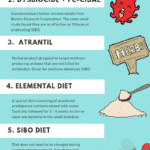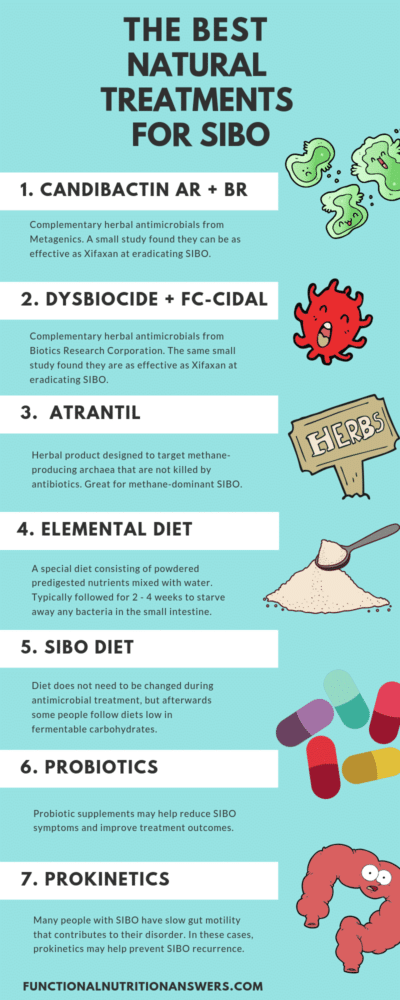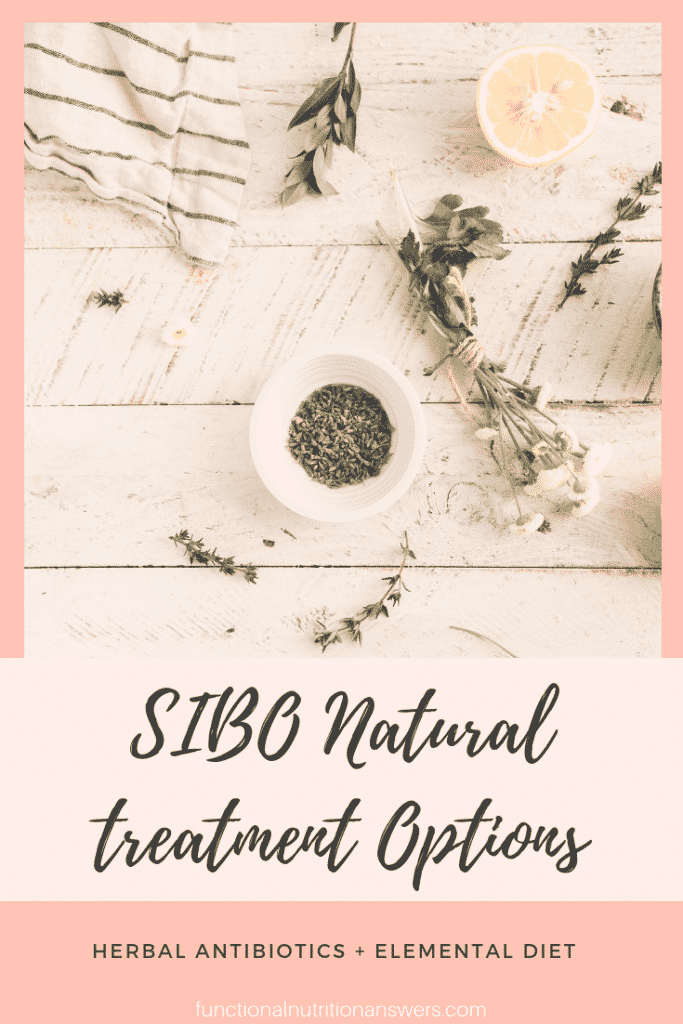Small intestinal bacterial overgrowth (SIBO) occurs bacteria grow in large numbers within the small intestine, causing gas, bloating, and malabsorption.
Treating SIBO requires killing off these unwanted bacteria and keeping them from recolonizing, which is typically done with prescription drugs and/or herbal supplements.
Since SIBO can be a difficult condition to treat, it is important to understand all of the different therapeutic options available.
In this article, we’ll help you navigate SIBO treatment options, elaborate on the natural (non-prescription) therapies, and review strategies for preventing relapse.
Want to save this article? Click here to get a PDF copy delivered to your inbox.
Please note that this article contains affiliate links. As an Amazon Associate, we earn from qualified purchases.
SIBO Treatment – What are the Main Options?
SIBO is a tough condition that often comes back and requires multiple rounds of treatment.
For the best outcomes, the infection should be eradicated, any associated nutrient deficiencies should be corrected, and the root cause(s) should be identified and managed (1).
There are three ways in which SIBO is commonly eradicated:
- Prescription antibiotics
- Herbal antimicrobials
- Elemental diet
The first two options kill the bacteria directly, while the elemental diet starves them out.
First, we will review how antibiotics are used to treat SIBO, then we’ll cover natural treatment approaches in more depth.
1. SIBO Antibiotics (Prescription Only)
To eradicate small intestinal bacterial overgrowth, the standard treatment is oral antibiotics, given for 2-4 weeks, depending on dose and symptom response (2).
Many different antibiotics may be used to treat SIBO, but rifaximin (brand name Xifaxan) has the most research to support its use (2).
If someone is a methane-producer, neomycin is often given alongside Xifaxan to improve outcomes (3).
Pros of Xifaxan
Xifaxan is more effective at eradicating SIBO than placebo and normalizes breath test results in 50% to 70% of patients (4, 5, 6).
It also significantly improves symptoms such as abdominal pain, bloating, and gas (7).
Xifaxan works well for treating SIBO because it is not absorbed systemically. It stays in the gut where it can kill the overgrown bacteria and is less likely to cause side effects (8, 9, 10, 11).
Thankfully, it does not appear to have negative effects on healthy bacteria that live in the colon (12, 13).
Cons of Xifaxan
While antibiotic treatment for SIBO is generally considered safe and effective, there are high rates of SIBO recurrence after treatment (4).
In one study, 44% of patients tested positive on a glucose breath test 9 months after a week-long treatment with Xifaxan (14).
Xifaxan is also very expensive ($$$$), but the makers of Xifaxan offer a program to reduce the copay price for people with insurance.
Although side effects are rare, some may experience headaches, diarrhea, and infections (11, 15).
Since Xifaxan doesn’t always work and can be very expensive, some people choose to investigate natural treatment options as well.
2. Herbal Antimicrobials for SIBO
Herbal antimicrobials (also called herbal antibiotics) can be affordable treatment alternatives for those who haven’t responded to antibiotics or who prefer natural therapies.
They can be purchased online or through a healthcare practitioner.
Pros of Herbal Antibiotics
Herbal antibiotics are oral supplements that contain natural herbs and spices that kill bacteria and other microorganisms.
They are typically taken for 4 weeks and have been shown to be at least as effective as prescription antibiotics for treating SIBO (16).
Herbal antimicrobials are also broad-spectrum, meaning that they can rid the gut of not just bacteria, but viruses, fungi, and parasites as well (17, 18).
This could be helpful for patients who suffer from both SIBO and SIFO (small intestinal fungal overgrowth) and/or parasitic infections (19).
Finally, many practitioners prefer herbal antimicrobials because they may be less likely to contribute to antibiotic resistance (20, 21, 22).
Cons of Herbal Antibiotics
Unfortunately, herbal antibiotics for the treatment of SIBO have not been very well studied.
More research is needed to better understand the most effective dosages and combinations of herbs for treatment.
We’ve compiled some of the most commonly used herbal treatments below and the evidence to support their use.
Commonly Used Herbal Antimicrobials for SIBO
Below are five of the most commonly used herbal antimicrobials for SIBO:
1. Candibactin-AR + Candibactin-BR
Candibactin-AR and Candibactin-BR are complementary antimicrobial products made by the supplement company Metagenics.
One small study found that 4 weeks of treatment with Candibactin-AR + BR (2 capsules of each supplement, 2x per day) was as effective as rifaximin for eradicating SIBO and just as safe (16).
Candibactin-AR contains thyme and oregano essential oils plus sage and lemon balm extracts.
Thyme oil is the main ingredient and is known to have strong antibacterial properties, even against multidrug-resistant strains of bacteria (23, 24).
Candibactin-BR contains a combination of herbal extracts including berberine, Oregon grape, coptis root, Chinese skullcap root, phellodendron bark, ginger rhizome, Chinese licorice root, and Chinese rhubarb root and rhizome.
The main ingredient in Candibactin-BR is berberine, which is a naturally-occurring chemical found in a variety of herbs, including goldenseal, coptis, barberry, and tree turmeric (17).
Berberine is often used for gastrointestinal infections, as it has antimicrobial effects against bacteria, viruses, fungi, and parasites (17, 18, 25, 26).
Candibactin AR can be purchased online here, and Candibactin BR can be purchased here.
2. Dysbiocide + FC-Cidal
Dysbiocide and FC-Cidal are herbal antimicrobial products made by Biotics Research Corporation.
They are often used together for the treatment of SIBO.
Dysbiocide includes herbs like dill seed, wormwood, and yarrow, all of which are known to exhibit antimicrobial activity (27, 28, 29).
FC-Cidal contains a blend of culinary herbs such as tarragon, thyme, and olive leaf.
Only one study has tested the effectiveness of these supplements, but a combination of Dysbiocide and FC-Cidal (two capsules of each, twice a day) taken for 4 weeks was found to be as effective as rifaximin for treating SIBO (16).
Dysbiocide can be purchased online here, and FC-Cidal can be purchased here.
3. Biocidin
Biocidin is an herbal supplement blend that includes bilberry extract, noni, milk thistle, echinacea, goldenseal, shiitake, white willow bark, garlic, grapeseed extract, black walnut, raspberry, fumitory, gentian, tea tree oil, galbanum oil, lavender oil, and oregano oil.
No published studies have evaluated Biocidin for the treatment of SIBO, but many of its ingredients are known to have antimicrobial properties (30, 31, 32, 33, 34).
Biocidin is made by Bio-Botanical Research and can be purchased online here.
4. DIY Herbal Combinations
Some practitioners prefer to make their own combinations of herbals for treating SIBO.
Typically, one or more of the following are taken daily for 4 weeks:
- Allicin (from garlic) (35, 36, 37)
- Berberine (found in goldenseal, Oregon grape, barberry, coptis, phellodendron) (18, 25, 26)
- Cinnamon (38, 39, 40)
- Neem (41, 42, 43)
- Oregano (44, 45, 46)
It’s usually preferred to combine several herbs during treatment since different ones target different bacteria and have synergistic effects (47).
While none of these herbs have been tested on their own for the treatment of SIBO, all are known for their antimicrobial properties, and many have been used for the treatment of other bacterial illnesses.
While promising, this herbal DIY approach to treating SIBO needs more research in order to determine the best combinations to use and how long treatment should last.
5. Atrantil
Atrantil (pronounced ahhh-tran-teal) is an over the counter supplement containing a combination of quebracho, conker tree, and M. balsamea Willd extracts.
It is designed to target methane-producing archaea, which can overgrow in cases of methane-dominant SIBO and are not killed by antibacterials.
One of the main ingredients, quebracho extract, comes from the bark of the quebracho tree in South America (48). Its antimicrobial properties are believed to be due to its high tannin content (49, 50, 51)
The seed of the conker tree, also called horse chestnut, has been used since the 1700s as a treatment for gastrointestinal disorders and appears to be effective due to its powerful anti-inflammatory and antioxidant properties (52, 53, 54, 55).
Mentha balsamea Willd, better known as peppermint, has been shown to inhibit the growth of pathogenic bacteria, alleviate symptoms, and improve quality of life in patients with IBS (56, 57, 58, 59).
No studies have evaluated the effectiveness of Atrantil for SIBO, but two small trials have studied the effects on patients diagnosed with IBS.
In 2015, a double-blind, placebo-controlled trial found that patients taking Atrantil experienced significant improvements in constipation and bloating after 2 weeks of treatment (60).
In 2016, a clinical trial found that 21 out of 24 patients reported significant improvements in abdominal pain, bloating, and constipation after taking Atrantil for 2 weeks; however, participants were not blinded, and there was no control group (61).
Neither study reported any adverse effects, but the sample sizes were small.
Atrantil can be purchased online here, and licensed healthcare practitioners can receive free samples here.
3. The Elemental Diet
The elemental diet is often seen as a “last resort” when it comes to SIBO treatment.
Those who don’t respond to multiple rounds of antibiotics or antimicrobials may benefit from an elemental diet, but this isn’t the first choice for most patients (62).
What is an Elemental Diet?
The elemental diet involves consuming a meal-replacement beverage that contains only the simplest forms of nutrients (glucose for carbs, fatty acids for fats, amino acids for protein, plus vitamins and minerals).
During the diet, you can only consume these powdered, predigested nutrients mixed with water for two to four weeks, and nothing else.
The idea is that these nutrients will be completely absorbed at the beginning of the small intestine and are not available to feed bacteria growing further downstream. Eventually, these bacteria will starve and die (62).
This allows for the patient to receive nourishment while the bacteria in the small intestine are eradicated.
Pros of the Elemental Diet
One study found that two weeks on an elemental diet normalized lactulose breath tests and improved symptoms in 80% of patients (63).
An additional 5% of patients had normalized breath tests after three weeks, indicating that some patients may need to stay on the diet longer to achieve results.
The overall success rate of the elemental diet was 85% in this study, which is pretty impressive when compared to the 50 to 70% success rate typically seen with antibiotics like rifaximin (5, 63).
Cons of the Elemental Diet
Unfortunately, most patients find the elemental diet difficult to follow because it is strict, unappetizing, and expensive.
Another concern is the high recurrence rate. If even one bacterium remains within the small intestine after treatment, it can quickly multiply and recolonize the small intestine when regular food is eaten again.
How to Begin an Elemental Diet
If you are interested in purchasing elemental diet powders, the Physicians’ Elemental Diet, by Integrative Therapeutics is the best-tasting choice and costs about $50 per day.
For those who cannot have corn, they also make a dextrose-free version sourced from tapioca.
Both varieties can be ordered through a healthcare practitioner. To find a functional nutrition practitioner near you, check out this online directory.
Vivonex, by Nestle, is another option, but it tastes really bad and uses lower quality ingredients.
It is also possible to make your own formula at home, but the ingredients are still relatively expensive and don’t taste great.
There are definitely pros and cons to consider, but an elemental diet can be a legitimate treatment option for the right person.
Preventing SIBO Recurrence
Unfortunately, SIBO is notoriously difficult to treat and relapse rates are high (2).
Thankfully, there are some ways to decrease the risk of recurrence, outlined below.
1. SIBO Diet
Along with treatment, many practitioners instruct SIBO patients to make dietary changes in order to prevent relapse.
Typically, diets low in fermentable carbohydrates are followed to reduce symptoms and decrease bacterial growth (since bacteria can feed on fermentable carbs and create gas/bloating in the process) (62).
The most commonly used SIBO diets are the low-FODMAP diet, Specific Carbohydrate Diet (SCD), Bi-Phasic diet, and Gut and Psychology Syndrome (GAPS) diet.
However, there is some disagreement over whether these special diets are effective and whether they should be followed during antimicrobial treatment.
In one camp, people believe these diets should be followed during treatment as an extra weapon to starve and kill the bacteria.
Others argue that bacteria need to be active and thriving in order to take up the antimicrobials and be effectively killed by them. They theorize that reducing carbohydrates simply causes bacteria to “go into hiding” inside biofilms and become more difficult to kill.
While there isn’t a whole lot of research on this topic, one study supports the idea that patients should continue to consume fermentable carbohydrates during treatment.
Researchers found that treating patients with rifaximin and a guar gum prebiotic supplement was more effective at eradicating SIBO than rifaximin alone (64).
After the SIBO has been eradicated, however, reducing dietary fermentable carbohydrates may be useful for preventing recurrence and keeping symptoms at bay.
It is important to note that diets low in fermentable carbohydrates may reduce the number of beneficial gut bacteria in the colon, so more research is needed to determine whether they are safe to follow long-term (65, 66).
2. Probiotics for SIBO
Research suggests that taking oral probiotics can help reduce symptoms and combat the overgrowth of bacteria in the small intestine (x).
According to one study, taking probiotics twice a day for 30 days reduced symptoms by 70% in people with IBS + SIBO (compared to just 10% symptom reduction in people who had IBS but no SIBO) (67).
In a very small study, 82% of SIBO patients receiving probiotics with antibiotic treatment felt their symptoms had improved, compared to only 52% of patients receiving only antibiotics (68).
Probiotic dosages and strains that are beneficial for SIBO include:
- 2 billion CFU of Bacillus clausii, 3x/day for 1 month (Enterogermina, a European product) (69).
- 1.5 billion CFU Saccharomyces boulardii, 1.75 billion CFU Bifidobacterium lactis, 1.75 billion CFU Lactobacillus acidophilus, and 0.5 billion CFU Lactobacillus plantarum, 2x/day for 30 days (Lactolevure, made in Greece) (67).
- 33 million CFU each of Lactobacillus casei, Lactobacillus plantarum, and Streptococcus faecalis and 10 million CFU Bifidobacterium brevis, 5 ml 2x/day for 5 days (Bioflora – couldn’t find it online) (68).
- 65 mL of Yakult daily for 6 weeks (70).
While it appears that probiotic supplementation can reduce symptoms, it is not clear whether it can actually prevent SIBO recurrence (71, 72).
However, it may be best to stop taking probiotics for at least one or two weeks prior to any breath testing, as they may interfere with results.
3. Prokinetics
Many patients with SIBO also experience dysmotility and delayed intestinal transit times (73).
This means that food moves more slowly than it should through the intestines, often because of a disturbance in the migrating motor complex (MMC) (74).
The MMC is the name for the pattern of contractions that occur in the gastrointestinal tract in between meals.
There is some evidence that disturbances in the MMC are one potential cause of SIBO because this prevents bacteria from being cleared from the small intestine into the colon (75, 76, 77, 78).
In order to correct these issues with the MMC, prokinetics are sometimes used.
Prokinetics are drugs or supplements that improve motility and reduce intestinal transit time (79).
While more research is needed to know exactly how prokinetics should fit into SIBO treatment, there is some evidence that they can help prevent a recurrence.
In one study, patients who were treated with tegaserod (a prokinetic drug) after successful SIBO treatment-experienced remission for an average of 200 days, while patients who received no prokinetics experienced only 41 days of remission (80).
A popular herbal prokinetic often used for IBS is Iberogast (81). One review found that Iberogast was as effective as standard prokinetics but with very minimal side effects (82).
Other supplements known to have prokinetic effects include ginger, 5-hydroxytryptophan (5-HTP), and artichoke extract (83, 84, 85).
Even if you’re not interested in taking any supplements, simply spacing meals 4-5 hours apart helps to allow the MMC to clear the intestines so that bacteria are not being provided with a constant supply of food (74, 86).
Final Thoughts
Conventional antibiotic treatment for SIBO is relatively effective, but the cost and potential side effects drive some patients to seek natural treatment options instead.
SIBO natural treatment options include herbal antimicrobials and the elemental diet.
Some clinical trials have found that herbal antimicrobials can be as effective as Xifaxan for eradicating SIBO.
Candibactin-AR and BR, Dysbiocide + FC-Cidal, and Atrantil have the most evidence to support their use in SIBO treatment.
Other herbal therapies have not been studied for their specific effects on SIBO, but are known for their antimicrobial properties and may still be useful in practice.
An elemental diet is a difficult but legitimate treatment option for patients who have not responded to other treatments.
To reduce the risk of relapse, a combination of dietary changes, probiotics, and prokinetic supplements may be used, although more research is needed.
Still, relapse rates are high, so multiple rounds of treatment may be necessary.
Want to save this article? Click here to get a PDF copy delivered to your inbox.

Amy is a registered dietitian nutritionist and experienced nutrition editor. She received her Masters in Nutrition Diagnostics from Cox College and her Bachelors in Dietetics from Missouri State University. She currently works as a nutrition editor for Healthline and Greatist. Her passion is finding ways to communicate nutrition research in an interesting and easy-to-understand way.




Concise, up to date information and manageble. Thanks so very much. I heard all this on a podcast that was only part of this info in a 10 part series and much of it was mentioned but this is so much better.
Thank you. I would be interested to know the limitations of the trials of the herbals. For example, the Candibactin trial had a very high drop-out rate.
I was given a Xifaxan treatment – 2 weeks of 2×3 a day, then 4 weeks of pause – and there will be 6 such cycles. I have Enterogermina as well – when to take it to make it sense? In these pause times? Or during Xifaxan?
I underwent a mitral valve replacement 10years back, doing well no cardiac issues.
I am suffering from SIBO resulted in erratic PT INR maintenance. Gas, constipation are regular problems. I have been taking Pantocid for more than 10years.
Please suggest me a remedy to come out of this problem.
Thanks
What diet do you recommend while on Atrantil?
This information is very well presented. It has all the important information written and displayed in a way that can be followed easily and consumed in a short period of time. It is well compiled and leaves me with a sense of being well informed. Thank you.
Very helpful article. I am just starting the SIBO elimination journey and so l am reading and gathering info. This was very clear. Thanks
Thank you for all of the valuable information & the links provided!!
What a fantastic and practical post—thank you!
how do i take candibactin ar and br
So great to know. Thanks for sharing!
Great post! Biocidin and prokinetics helped me out greatly!
Wow, you did a fabulous job of researching this topic extensively!
An incredibly comprehensive post Amy! Thank you!
Thanks so much for creating this! What a great resource for anyone who suffers from SIBO
This is such helpful info!
Super great info on a topic that is becoming more widely known about! I didn’t know this condition could be treated naturally so I have been very enlightened!
Great article! I actually am seeing a patient who is concerned about SIBO, this will be so useful!
Super helpful information!
What are your thoughts on combining partially hydrolyzed guar gum with an herbal treatment?